An official website of the United States government
 United States Department of Labor
United States Department of Labor
Keep buildings in clean and orderly condition. Perform heavy cleaning duties, such as cleaning floors, shampooing rugs, washing walls and glass, and removing rubbish. Duties may include tending furnace and boiler, performing routine maintenance activities, notifying management of need for repairs, and cleaning snow or debris from sidewalk.
Employment estimate and mean wage estimates for this occupation:
| Employment (1) | Employment RSE (3) |
Mean hourly wage |
Mean annual wage (2) |
Wage RSE (3) |
|---|---|---|---|---|
| 2,145,450 | 0.5 % | $14.43 | $30,010 | 0.3 % |
Percentile wage estimates for this occupation:
| Percentile | 10% | 25% | 50% (Median) |
75% | 90% |
|---|---|---|---|---|---|
| Hourly Wage | $9.43 | $11.08 | $13.19 | $16.80 | $21.58 |
| Annual Wage (2) | $19,620 | $23,050 | $27,430 | $34,950 | $44,880 |
Industries with the highest published employment and wages for this occupation are provided. For a list of all industries with employment in this occupation, see the Create Customized Tables function.
Industries with the highest levels of employment in this occupation:
| Industry | Employment (1) | Percent of industry employment | Hourly mean wage | Annual mean wage (2) |
|---|---|---|---|---|
| Services to Buildings and Dwellings | 883,360 | 40.30 | $13.43 | $27,930 |
| Elementary and Secondary Schools | 310,770 | 3.61 | $16.11 | $33,510 |
| Local Government, excluding schools and hospitals (OES Designation) | 73,510 | 1.33 | $17.58 | $36,570 |
| Colleges, Universities, and Professional Schools | 70,920 | 2.30 | $15.93 | $33,140 |
| General Medical and Surgical Hospitals | 70,100 | 1.26 | $14.75 | $30,690 |
Industries with the highest concentration of employment in this occupation:
| Industry | Employment (1) | Percent of industry employment | Hourly mean wage | Annual mean wage (2) |
|---|---|---|---|---|
| Services to Buildings and Dwellings | 883,360 | 40.30 | $13.43 | $27,930 |
| Facilities Support Services | 24,600 | 14.95 | $13.31 | $27,690 |
| Vocational Rehabilitation Services | 20,260 | 6.23 | $12.69 | $26,400 |
| Religious Organizations | 11,340 | 5.64 | $14.57 | $30,300 |
| Real Estate | 69,930 | 4.20 | $16.74 | $34,820 |
Top paying industries for this occupation:
| Industry | Employment (1) | Percent of industry employment | Hourly mean wage | Annual mean wage (2) |
|---|---|---|---|---|
| Postal Service (federal government) | 13,780 | 2.18 | $24.59 | $51,150 |
| Monetary Authorities-Central Bank | 30 | 0.18 | $21.40 | $44,520 |
| Local Messengers and Local Delivery | 80 | 0.09 | $20.43 | $42,500 |
| Nonmetallic Mineral Mining and Quarrying | 110 | 0.10 | $19.28 | $40,110 |
| Warehousing and Storage | 8,460 | 0.70 | $19.00 | $39,530 |
States and areas with the highest published employment, location quotients, and wages for this occupation are provided. For a list of all areas with employment in this occupation, see the Create Customized Tables function.
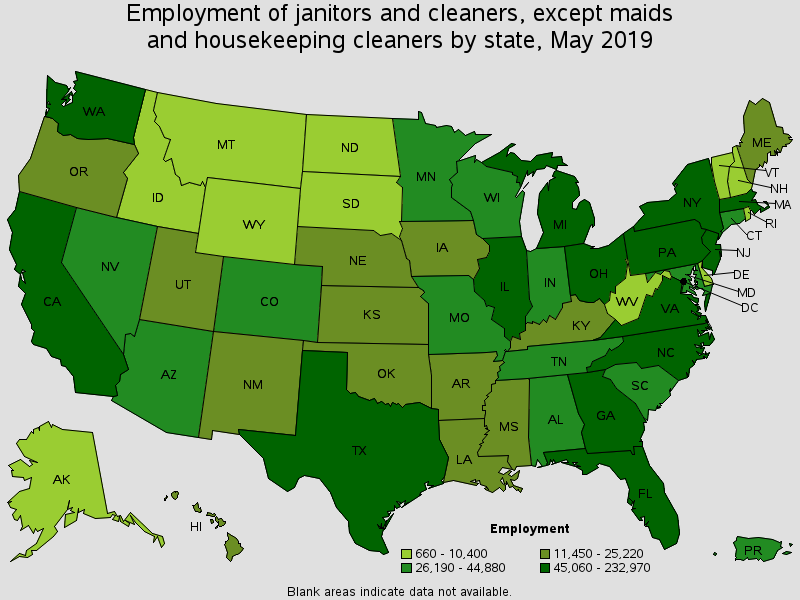
States with the highest employment level in this occupation:
| State | Employment (1) | Employment per thousand jobs | Location quotient (9) | Hourly mean wage | Annual mean wage (2) |
|---|---|---|---|---|---|
| California | 232,970 | 13.40 | 0.92 | $16.77 | $34,870 |
| New York | 190,730 | 20.03 | 1.37 | $17.50 | $36,400 |
| Texas | 168,160 | 13.53 | 0.93 | $12.38 | $25,760 |
| Florida | 116,830 | 13.28 | 0.91 | $12.77 | $26,560 |
| Illinois | 94,280 | 15.65 | 1.07 | $14.80 | $30,790 |
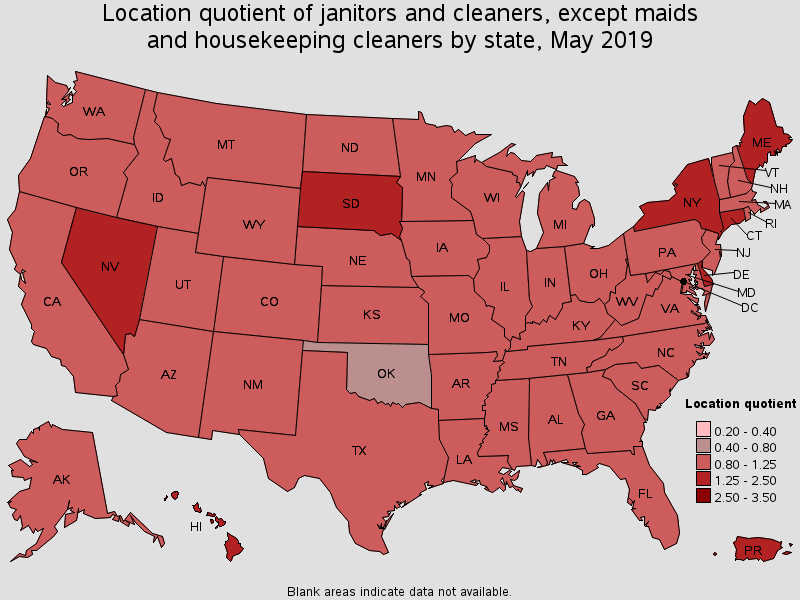
States with the highest concentration of jobs and location quotients in this occupation:
| State | Employment (1) | Employment per thousand jobs | Location quotient (9) | Hourly mean wage | Annual mean wage (2) |
|---|---|---|---|---|---|
| Nevada | 29,360 | 21.08 | 1.44 | $15.32 | $31,860 |
| New York | 190,730 | 20.03 | 1.37 | $17.50 | $36,400 |
| Delaware | 8,840 | 19.57 | 1.34 | $14.05 | $29,220 |
| South Dakota | 8,250 | 19.41 | 1.33 | $12.87 | $26,770 |
| Maine | 11,450 | 18.74 | 1.28 | $15.14 | $31,480 |
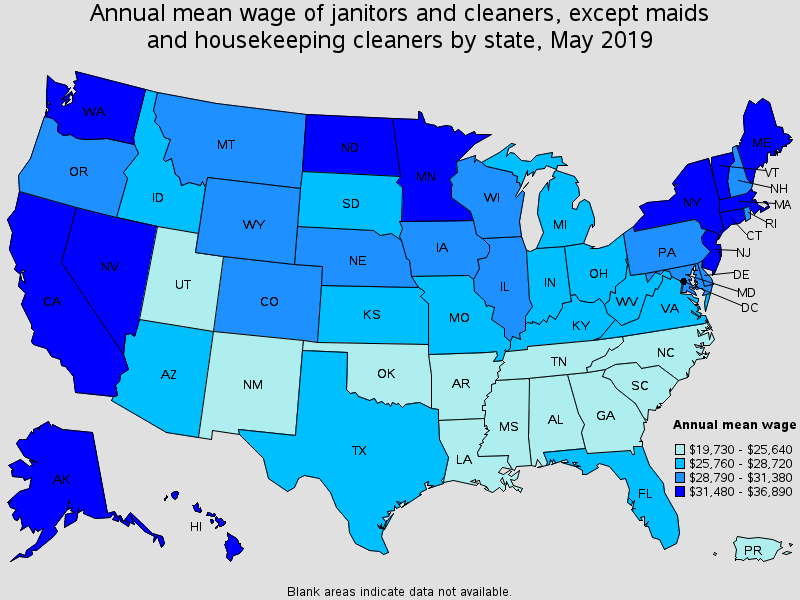
Top paying States for this occupation:
| State | Employment (1) | Employment per thousand jobs | Location quotient (9) | Hourly mean wage | Annual mean wage (2) |
|---|---|---|---|---|---|
| Massachusetts | 55,570 | 15.35 | 1.05 | $17.73 | $36,890 |
| Washington | 45,060 | 13.58 | 0.93 | $17.62 | $36,650 |
| New York | 190,730 | 20.03 | 1.37 | $17.50 | $36,400 |
| Connecticut | 30,920 | 18.57 | 1.27 | $17.17 | $35,720 |
| District of Columbia | 12,300 | 17.00 | 1.16 | $16.86 | $35,070 |
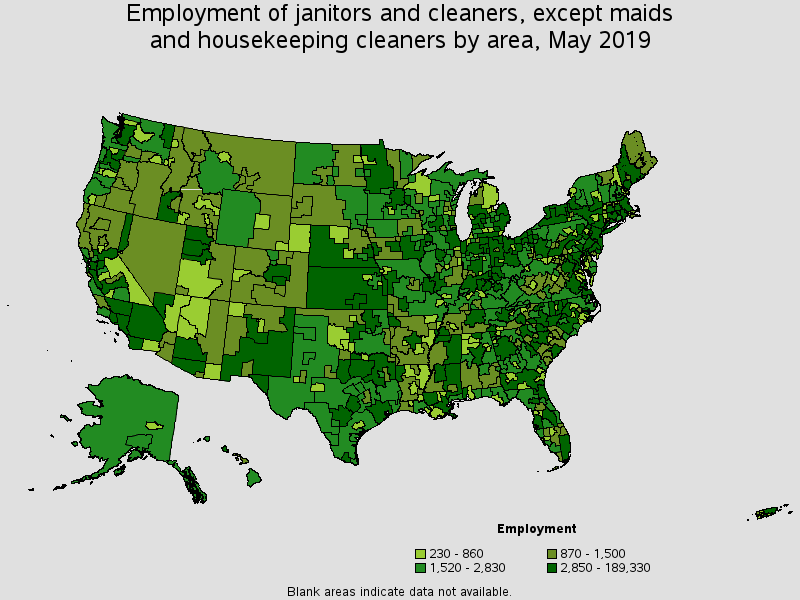
Metropolitan areas with the highest employment level in this occupation:
| Metropolitan area | Employment (1) | Employment per thousand jobs | Location quotient (9) | Hourly mean wage | Annual mean wage (2) |
|---|---|---|---|---|---|
| New York-Newark-Jersey City, NY-NJ-PA | 189,330 | 19.61 | 1.34 | $17.85 | $37,140 |
| Los Angeles-Long Beach-Anaheim, CA | 85,160 | 13.65 | 0.93 | $16.39 | $34,090 |
| Chicago-Naperville-Elgin, IL-IN-WI | 74,570 | 15.95 | 1.09 | $14.98 | $31,160 |
| Washington-Arlington-Alexandria, DC-VA-MD-WV | 52,540 | 16.52 | 1.13 | $15.31 | $31,840 |
| Boston-Cambridge-Nashua, MA-NH | 44,660 | 15.96 | 1.09 | $17.93 | $37,300 |
| Philadelphia-Camden-Wilmington, PA-NJ-DE-MD | 44,220 | 15.37 | 1.05 | $15.05 | $31,300 |
| Dallas-Fort Worth-Arlington, TX | 43,470 | 11.89 | 0.81 | $13.15 | $27,350 |
| Houston-The Woodlands-Sugar Land, TX | 43,170 | 14.14 | 0.97 | $12.03 | $25,020 |
| Miami-Fort Lauderdale-West Palm Beach, FL | 38,420 | 14.54 | 1.00 | $12.55 | $26,100 |
| San Francisco-Oakland-Hayward, CA | 32,370 | 13.09 | 0.90 | $18.69 | $38,870 |
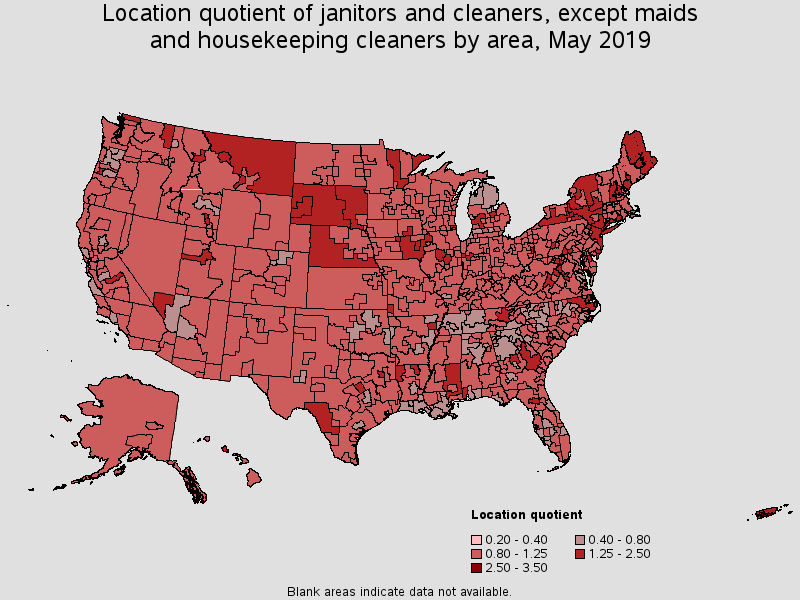
Metropolitan areas with the highest concentration of jobs and location quotients in this occupation:
| Metropolitan area | Employment (1) | Employment per thousand jobs | Location quotient (9) | Hourly mean wage | Annual mean wage (2) |
|---|---|---|---|---|---|
| Saginaw, MI | 2,280 | 26.70 | 1.83 | $14.10 | $29,330 |
| Atlantic City-Hammonton, NJ | 3,480 | 26.34 | 1.80 | $16.06 | $33,410 |
| Harrisonburg, VA | 1,680 | 26.11 | 1.79 | $12.17 | $25,310 |
| Ithaca, NY | 1,240 | 24.75 | 1.69 | $16.32 | $33,940 |
| Las Vegas-Henderson-Paradise, NV | 23,720 | 23.25 | 1.59 | $15.68 | $32,620 |
| Bangor, ME | 1,470 | 22.38 | 1.53 | $14.37 | $29,900 |
| Bellingham, WA | 2,000 | 22.35 | 1.53 | $15.94 | $33,150 |
| Rapid City, SD | 1,450 | 22.06 | 1.51 | $12.53 | $26,070 |
| Missoula, MT | 1,330 | 21.83 | 1.49 | $13.34 | $27,740 |
| Binghamton, NY | 2,190 | 21.81 | 1.49 | $13.43 | $27,940 |
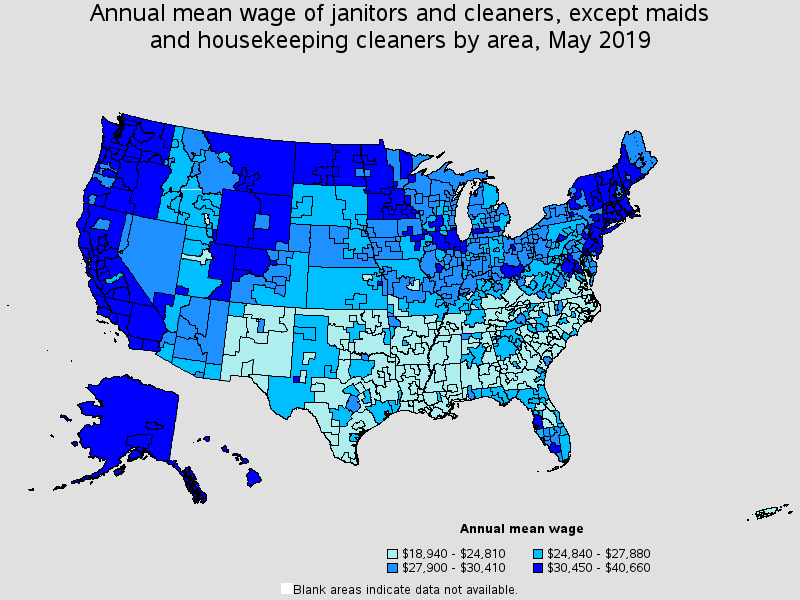
Top paying metropolitan areas for this occupation:
| Metropolitan area | Employment (1) | Employment per thousand jobs | Location quotient (9) | Hourly mean wage | Annual mean wage (2) |
|---|---|---|---|---|---|
| Barnstable Town, MA | 1,260 | 12.12 | 0.83 | $19.20 | $39,930 |
| San Francisco-Oakland-Hayward, CA | 32,370 | 13.09 | 0.90 | $18.69 | $38,870 |
| Seattle-Tacoma-Bellevue, WA | 25,160 | 12.45 | 0.85 | $18.67 | $38,830 |
| Fairbanks, AK | 490 | 14.60 | 1.00 | $18.21 | $37,880 |
| Mount Vernon-Anacortes, WA | 740 | 14.76 | 1.01 | $18.14 | $37,730 |
| San Jose-Sunnyvale-Santa Clara, CA | 17,540 | 15.37 | 1.05 | $17.96 | $37,350 |
| Boston-Cambridge-Nashua, MA-NH | 44,660 | 15.96 | 1.09 | $17.93 | $37,300 |
| New York-Newark-Jersey City, NY-NJ-PA | 189,330 | 19.61 | 1.34 | $17.85 | $37,140 |
| Kahului-Wailuku-Lahaina, HI | 1,280 | 16.79 | 1.15 | $17.84 | $37,100 |
| Hartford-West Hartford-East Hartford, CT | 9,770 | 16.72 | 1.14 | $17.83 | $37,080 |
Nonmetropolitan areas with the highest employment in this occupation:
| Nonmetropolitan area | Employment (1) | Employment per thousand jobs | Location quotient (9) | Hourly mean wage | Annual mean wage (2) |
|---|---|---|---|---|---|
| Kansas nonmetropolitan area | 6,180 | 15.67 | 1.07 | $12.63 | $26,260 |
| North Northeastern Ohio non-metropolitan area (non-contiguous) | 4,810 | 14.41 | 0.99 | $13.72 | $28,540 |
| Southeast Iowa nonmetropolitan area | 4,670 | 20.79 | 1.42 | $13.11 | $27,270 |
| North Texas Region of Texas nonmetropolitan area | 4,060 | 14.68 | 1.00 | $11.70 | $24,330 |
| Southeast Coastal North Carolina nonmetropolitan area | 3,970 | 15.96 | 1.09 | $11.16 | $23,220 |
Nonmetropolitan areas with the highest concentration of jobs and location quotients in this occupation:
| Nonmetropolitan area | Employment (1) | Employment per thousand jobs | Location quotient (9) | Hourly mean wage | Annual mean wage (2) |
|---|---|---|---|---|---|
| Border Region of Texas nonmetropolitan area | 1,630 | 26.96 | 1.85 | $10.00 | $20,810 |
| Central East New York nonmetropolitan area | 3,650 | 22.85 | 1.56 | $13.84 | $28,790 |
| West South Dakota nonmetropolitan area | 1,330 | 22.03 | 1.51 | $12.35 | $25,680 |
| Southeast Iowa nonmetropolitan area | 4,670 | 20.79 | 1.42 | $13.11 | $27,270 |
| South Nebraska nonmetropolitan area | 3,100 | 20.68 | 1.42 | $14.62 | $30,410 |
Top paying nonmetropolitan areas for this occupation:
| Nonmetropolitan area | Employment (1) | Employment per thousand jobs | Location quotient (9) | Hourly mean wage | Annual mean wage (2) |
|---|---|---|---|---|---|
| Connecticut nonmetropolitan area | 500 | 15.38 | 1.05 | $19.55 | $40,660 |
| Massachusetts nonmetropolitan area | 880 | 14.48 | 0.99 | $17.98 | $37,400 |
| Alaska nonmetropolitan area | 1,790 | 16.48 | 1.13 | $17.71 | $36,840 |
| West North Dakota nonmetropolitan area | 1,560 | 12.43 | 0.85 | $17.03 | $35,430 |
| Southern Vermont nonmetropolitan area | 1,770 | 16.49 | 1.13 | $16.56 | $34,440 |
These estimates are calculated with data collected from employers in all industry sectors, all metropolitan and nonmetropolitan areas, and all states and the District of Columbia. The top employment and wage figures are provided above. The complete list is available in the downloadable XLS files.
The percentile wage estimate is the value of a wage below which a certain percent of workers fall. The median wage is the 50th percentile wage estimate--50 percent of workers earn less than the median and 50 percent of workers earn more than the median. More about percentile wages.
(1) Estimates for detailed occupations do not sum to the totals because the totals include occupations not shown separately. Estimates do not include self-employed workers.
(2) Annual wages have been calculated by multiplying the hourly mean wage by a "year-round, full-time" hours figure of 2,080 hours; for those occupations where there is not an hourly wage published, the annual wage has been directly calculated from the reported survey data.
(3) The relative standard error (RSE) is a measure of the reliability of a survey statistic. The smaller the relative standard error, the more precise the estimate.
(9) The location quotient is the ratio of the area concentration of occupational employment to the national average concentration. A location quotient greater than one indicates the occupation has a higher share of employment than average, and a location quotient less than one indicates the occupation is less prevalent in the area than average.
Other OES estimates and related information:
May 2019 National Occupational Employment and Wage Estimates
May 2019 State Occupational Employment and Wage Estimates
May 2019 Metropolitan and Nonmetropolitan Area Occupational Employment and Wage Estimates
May 2019 National Industry-Specific Occupational Employment and Wage Estimates
Last Modified Date: July 6, 2020